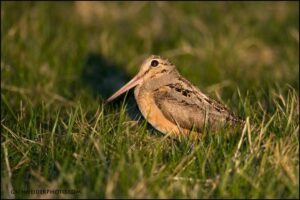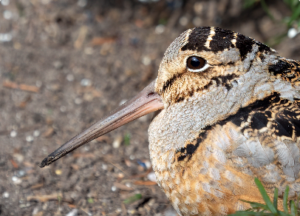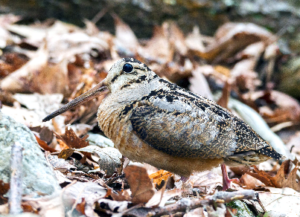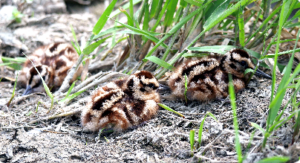By volunteer
 By Bill Napper, Volunteer Naturalist and Bernheim at Night Program Leader
By Bill Napper, Volunteer Naturalist and Bernheim at Night Program Leader
In many ways, the American woodcock is like a walking optical illusion. It’s as if a committee designed the Woodcock, and everyone had their own idea of what it should look like. “Let’s give it a round body!” “Let’s make its legs short and stubby!” “Add a bill long enough to double as a back scratcher!” “Sure, why not?” And let’s not forget about Woodcock’s plumage, which is a dizzying array of brown and gray that would make even the most skilled fashion designer scratch their head. And somehow, all these features came together to create the American Woodcock, a bird that looks like a Picasso painting come to life, but with feathers. The Seneca Indians believed that the Creator made the Woodcock from the leftover parts of every other bird.
 The woodcock seems to be an unusual bird to find in a forest. It belongs to the Charadriiformes order, which typically includes hundreds of bird species that reside near shorelines. Despite this, there are several Charadriiformes species that live inland or away from the coast. Here is a small sampling of inland shorebirds that can be found at Bernheim Forest at different times of the year. The Wilson’s Snipe (Gallinago delicata) is present in Bernheim only during the winter months, while the upland sandpiper (Bartramia longicauda) passes through the area during migration to and from northern breeding grounds. The American woodcock (Scolopax minor) and the spotted sandpiper (Actitis macularius) both may nest in Bernheim during the warmer months. The killdeer (Charadrius vociferus) is a familiar year-round resident at Bernheim.
The woodcock seems to be an unusual bird to find in a forest. It belongs to the Charadriiformes order, which typically includes hundreds of bird species that reside near shorelines. Despite this, there are several Charadriiformes species that live inland or away from the coast. Here is a small sampling of inland shorebirds that can be found at Bernheim Forest at different times of the year. The Wilson’s Snipe (Gallinago delicata) is present in Bernheim only during the winter months, while the upland sandpiper (Bartramia longicauda) passes through the area during migration to and from northern breeding grounds. The American woodcock (Scolopax minor) and the spotted sandpiper (Actitis macularius) both may nest in Bernheim during the warmer months. The killdeer (Charadrius vociferus) is a familiar year-round resident at Bernheim.
You may be thinking the woodcock couldn’t get any stranger, but that’s not true! Its eyes are in a class of their own. They’re positioned high and set back on the head, giving the bird an impressive near 360-degree view of its surroundings. To accommodate this unique eye location, other body parts also had to be repositioned. Its ears are on its neck and its brain actually lies upside down at the bottom of the skull.
 Given its unique appearance, it’s no surprise that the Woodcock has garnered many colorful nicknames. These include “Timberdoodle,” “Bogsucker,” “Swamp Bat,” “Mud Bat,” “Labrador Twister,” “Night Partridge,” “Mud Snipe,” “Big-eye,” “Fiddle Squeak,” and “Little Chicken of the Woods.” Interestingly, a group of woodcocks is called a “fall,” which is very appropriate as that accurately describes the sudden plummet back to the ground males perform during their spring mating ritual.
Given its unique appearance, it’s no surprise that the Woodcock has garnered many colorful nicknames. These include “Timberdoodle,” “Bogsucker,” “Swamp Bat,” “Mud Bat,” “Labrador Twister,” “Night Partridge,” “Mud Snipe,” “Big-eye,” “Fiddle Squeak,” and “Little Chicken of the Woods.” Interestingly, a group of woodcocks is called a “fall,” which is very appropriate as that accurately describes the sudden plummet back to the ground males perform during their spring mating ritual.
American woodcocks are considered migratory, but often they only migrate just far enough south to escape the worst of the cold winter. By migrating only a few states away, they can quickly return to their cherished Bernheim breeding grounds in late February or early March when the weather improves. Woodcocks fly at low altitudes of around 50 feet during migration, mostly at night. Unfortunately, this makes them vulnerable to obstacles like windmills and tall power lines that humans have built in their path.
During the spring breeding season, the male American woodcock performs an intriguing crepuscular courtship display. Each morning and evening, when the mood lighting is just right, the male emerges from the woods and positions himself on the ground in an open area known as his “singing ground”. He repeatedly makes his nasally “peent” love call while hopping and turning 90 degrees until he has spun 360 degrees in a circle to ensure all potential mates have heard the invitation. Then it happens, the glorious “Sky Dance.” Here’s how the great naturalist Aldo Leopold described the “Sky Dance” in his classic A Sand County Almanac:
 “Suddenly the peenting ceases and the bird flutters skyward in a series of wide spirals, emitting a musical twitter. Up and up he goes, the spirals steeper and smaller, the twittering louder and louder, until the performer is only a speck in the sky. Then, without warning, he tumbles like a crippled plane, giving voice in a soft liquid warble that a March bluebird might envy. At a few feet from the ground he levels off and returns to his peenting ground, usually to the exact spot where the performance began, and there resumes his peenting.”
“Suddenly the peenting ceases and the bird flutters skyward in a series of wide spirals, emitting a musical twitter. Up and up he goes, the spirals steeper and smaller, the twittering louder and louder, until the performer is only a speck in the sky. Then, without warning, he tumbles like a crippled plane, giving voice in a soft liquid warble that a March bluebird might envy. At a few feet from the ground he levels off and returns to his peenting ground, usually to the exact spot where the performance began, and there resumes his peenting.”
The hen Woodcock typically nests within 150 yards of the mating site, and the male plays no role in nest site selection or rearing young. Nests are slight depressions in dead leaves and contain about four camouflaged eggs. Incubation lasts 19-22 days, and the eggs hatch from early April to mid-June. Predators include dogs, cats, skunks, opossums, raccoons, foxes, ravens, crows, and snakes. Hens may re-nest if the first clutch is lost, usually laying only three eggs the second time around.
 Woodcock eggs split lengthwise, a unique trait among birds. Chicks are precocial and can leave the nest just hours after hatching, covered in pale brownish down with darker spots and stripes. They freeze when threatened and snuggle under their mother’s warm embrace to stay dry and cozy. After two weeks, chicks can fly short distances, and in four weeks, they look like mini-adults. The family separates when young are six to eight weeks old.
Woodcock eggs split lengthwise, a unique trait among birds. Chicks are precocial and can leave the nest just hours after hatching, covered in pale brownish down with darker spots and stripes. They freeze when threatened and snuggle under their mother’s warm embrace to stay dry and cozy. After two weeks, chicks can fly short distances, and in four weeks, they look like mini-adults. The family separates when young are six to eight weeks old.
The male American woodcock may be known for his impressive aerial displays and unique vocalizations, but have you seen a woodcock shuffle? Both male and female woodcocks, even the little ones, shuffle as they walk, taking short, quick steps, and bobbing their heads back and forth like they’re on the dance floor. It’s like they’re grooving to a secret beat that only they can hear. Watching the American woodcock shuffle and bob might make you wonder if our greatest pop stars got their moves from these little birds.
Woodcock populations have plummeted by 55% since the 1970s, with habitat loss as a leading culprit. Their ideal habitat of damp woodland edges with clearings is disappearing. However, experts believe there may be other factors at play, making the population decrease more complex than initially thought. Fortunately, Bernheim’s forest offers the perfect habitat of damp woodland edges with small open clearings.
Despite their small size and secretive behavior, American woodcocks play an important role in their ecosystems. They help control insect populations, and their habitat preferences can help promote forest regeneration and diversity.
The American woodcock is a fascinating and elusive bird that is well worth seeking out in the wild. With its distinctive appearance, courtship display, and groovy moves, this little bird is a favorite of birdwatchers and nature enthusiasts across North America. Whether you call it a Timberdoodle, a Bogsucker, or a Little Chicken of the Woods, the American Woodcock is a true marvel of the natural world.
Want to learn more about these fascinating oddballs? Join us on Saturday, March 18 for Creatures of the Night: Dance of the Timberdoodle.

